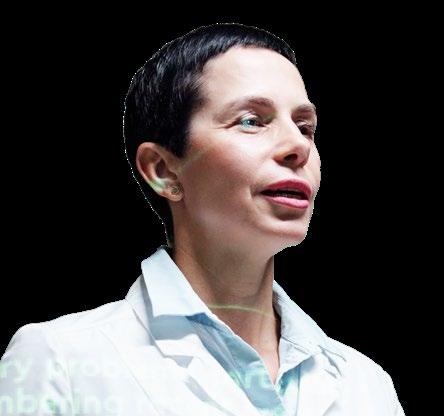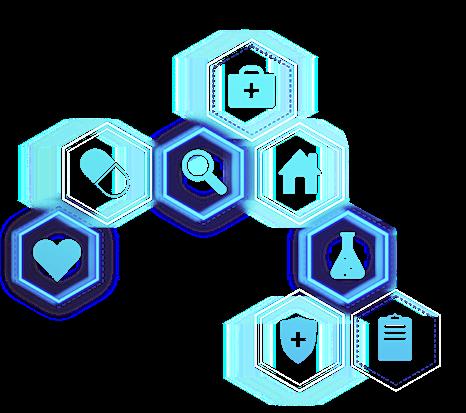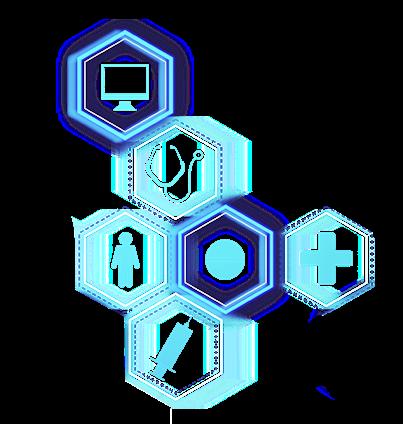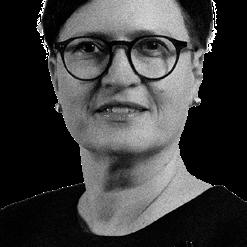HLTH Europe 2025
Expert-led Congress Features:
Where Vision Meets Action and Broadening Horizons in Health Innovation
Interviews:
Henry Stoneley, Nikita Kanani, Aiga Balode, Nada Abedin, and Miles Payling share insights from HLTH Europe 2025


05 Welcome
Congress Review
06 Review of HLTH Europe 2025, 16th–19th June 2025
Congress Feature
13 HLTH Europe 2025: Where Vision Meets Action
Masood Nazir
16 Broadening Horizons in Health Innovation: Insights from HLTH Europe 2025
Rozelle Kane
Congress Interviews
20 Henry Stoneley 22 Nikita Kanani 24 Aiga Balode
Nada Abedin 30 Miles Payling

"Attendees
were reminded of the need to recognise and honour the health rights of all people, across borders and circumstances"

Aims and Scope
EMJ Innovations is an open-access, peer-reviewed eJournal published annually, which covers new solutions and improvements in medicine in the form of new methods, products, and technologies for healthcare. The journal is aimed at healthcare professionals and presents the key technological advances in medicine alongside the most cutting-edge clinical research.
EMJ Innovations covers key congresses in health technology and innovation and also publishes peer-reviewed research papers, review articles, and case reports in the field. In addition, the journal welcomes the submission of features and opinion pieces intended to create a discussion around key topics in the field and broaden readers’ professional interests. The journal is managed by a dedicated editorial team that adheres to a rigorous double-blind peer-review process, maintains high standards of copy editing, and ensures timely publication.
Further details on coverage can be found here: www.emjreviews.com
Editorial Expertise
EMJ is supported by various levels of expertise:
• Guidance from an Editorial Board consisting of leading authorities from a wide variety of disciplines.
• Invited contributors who are recognised authorities in their respective fields.
• Peer review, which is conducted by expert reviewers who are invited by the Editorial team and appointed based on their knowledge of a specific topic.
• An experienced team of editors and technical editors.

Peer Review
On submission, all articles are assessed by the editorial team to determine their suitability for the journal and appropriateness for peer review.
Editorial staff, following consultation with either a member of the Editorial Board or the author(s) if necessary, identify three appropriate reviewers, who are selected based on their specialist knowledge in the relevant area.
All peer review is double blind. Following review, papers are either accepted without modification, returned to the author(s) to incorporate required changes, or rejected.
Editorial staff have final discretion over any proposed amendments.
Submissions
We welcome contributions from professionals, consultants, academics, and industry leaders on relevant and topical subjects. We seek papers with the most current, interesting, and relevant information in each therapeutic area and accept original research, review articles, case reports, and features.
We are always keen to hear from healthcare professionals wishing to discuss potential submissions, please email: editorial.assistant@emjreviews.com
To submit a paper, use our online submission site: www.editorialmanager.com/e-m-j
Submission details can be found through our website: www.emjreviews.com/contributors/authors
Reprints
All articles included in EMJ are available as reprints (minimum order 1,000). Please contact hello@emjreviews.com if you would like to order reprints.
Distribution and Readership
EMJ is distributed through controlled circulation to healthcare professionals in the relevant fields across Europe.
Indexing and Availability
EMJ is indexed on DOAJ, the Royal Society of Medicine, and Google Scholar®; selected articles are indexed in PubMed Central®
EMJ is available through the websites of our leading partners and collaborating societies. EMJ journals are all available via our website: www.emjreviews.com
Open Access
This is an open-access journal in accordance with the Creative Commons Attribution-Non Commercial 4.0 (CC BY-NC 4.0) license.
Congress Notice
Staff members attend medical congresses as reporters when required.
This Publication
Publication Date: July 2025 Online ISSN: 2513-8634
All information obtained by EMJ and each of the contributions from various sources is as current and accurate as possible. However, due to human or mechanical errors, EMJ and the contributors cannot guarantee the accuracy, adequacy, or completeness of any information, and cannot be held responsible for any errors or omissions. EMJ is completely independent of the review event (HLTH Europe 2025) and the use of the organisation does not constitute endorsement or media partnership in any form whatsoever. The cover photo is of Amsterdam, the Netherlands, the location of HLTH Europe 2025.
Front cover and contents photograph: Amsterdam, the Netherlands © andreykr / stock.adobe.com
Don't Miss What's Trending: Our Most Listened To Innovations Episodes
Longevity Medicine
Explore how functional medicine, biohacking, and evolutionary biology can be used to transform modern health care, improve health span, and prevent chronic disease.
Listen now
Human versus Machine: Navigating Clinical Safety
Learn more about the clinical application of AI and the challenges of ensuring patient safety in an increasingly digital world.
Listen now
Innovating Medical Education: From Anatomy Labs to 3D Printing
Discover the latest advancements in ultrasound imaging for anatomy education, and the innovative applications of 3D printing in medicine.
Listen now








Managing Editor
Darcy Richards
Copy Editors
Noémie Fouarge, Sarah Jahncke, Aranii Nagarajah
Editorial Leads
Helena Bradbury, Ada Enesco
Editorial Co-ordinators
Jenna Lorge, Bertie Pearcey
Editorial Assistants
Katrina Thornber, Katie Wright, Aleksandra Zurowska
Creative Director
Tim Uden
Design Manager
Stacey White
Senior Designer
Owen Silcox
Creative Artworker
Dillon Benn Grove
Designers
Shanjok Gurung, Fabio van Paris
Head of Marketing
Stephanie Corbett
Chief Executive Officer
Justin Levett
Chief Commercial Officer
Dan Healy
Founder and Chairman
Spencer Gore
Welcome
Dear Readers,
We are pleased to introduce this supplement issue of EMJ Innovations, which features coverage of the HLTH Europe 2025 healthcare innovation event, held in Amsterdam, the Netherlands, between the 16th–19th June.
The key theme of this year’s event was ‘growth in all its forms’, reflecting on progress but also mapping out the landscape for continued development. From the digital transformation of healthcare to policy, sustainability, resilience, innovation, and AI, HLTH Europe 2025 brought together clinical trailblazers to spotlight new research and spark conversation around how healthcare can be improved and future-proofed across Europe. Two features, written by attending clinicians, emphasise the pivotal updates presented over the course of the event.
You can also discover key insights from the event in an exclusive interview with the Head of Health Systems and Providers at HLTH Europe, Henry Stonely, plus expert opinions on systemic biases in women’s health, clinicianled AI development, and the regulatory frameworks required to drive the future of healthcare.
As we continue to look forward and strive to raise the quality of healthcare globally, we hope you enjoy reading this exploration of research and potentially revolutionary ideas that are set to transform the healthcare space in the near future.
Contact us
Editorial enquiries: editor@emjreviews.com
Sales opportunities: salesadmin@emjreviews.com
Permissions and copyright: accountsreceivable@emjreviews.com
Reprints: info@emjreviews.com Media enquiries: marketing@emjreviews.com
HLTH EUROPE 2025
Review of HLTH Europe 2025 Congress Review
Location: Amsterdam, the Netherlands
Date: 16th–19th June, 2025
Citation: EMJ Innov. 2025;9[Suppl 2]:6-12. https://doi.org/10.33590/emjinnov/CRRG8163
EUROPE’s number one healthcare innovation event, HLTH Europe, was held this year in Amsterdam, the Netherlands, from the 16th–19th June, 2025, with over 5,000 leaders and innovators from all corners of the healthcare ecosystem. Attendees and speakers included representatives from health systems and providers, startups, government, healthtech, pharmaceutical and life science companies, insurers, investment sectors, and more.
Known for its world-class speakers, immersive attendee experiences, incredible networking events, and impactful networking programmes, HLTH Europe continues to fulfil its mission of empowering individuals within healthcare to solve complex challenges, foster innovation, and catalyse change for good and for all.
Building on a successful European debut in 2024 and HLTH’s ongoing success in the USA, this year's event provided a platform for experts to tackle Europe’s unique healthcare opportunities and hurdles.

HLTH Europe continues to fulfil its mission of empowering individuals within healthcare to solve complex challenges, foster innovation, and catalyse change for good and for all
2025 Theme: Growth in all its forms
This year’s agenda reflected the evolution of traditional care models towards more flexible and interconnected approaches in the health ecosystem. Speakers and panels addressed tough challenges, such as the limitations of outdated IT systems and the pressing need for innovative, inclusive solutions. In particular, the agenda addressed the following eight key topics:
1
Clicks and mortar: How hospital IT is changing healthcare
2 Charting GPT: Mapping the next steps for data and AI
3 Breaking the mould: New models of care
4 Shaping the health systems of tomorrow: A glimpse into the future, today
5
Access granted: The health equity evolution
6 Bureaucracy and balance sheets: Bridging the innovation/ reimbursement gap
7 Mind matters: Shaping the future of mental and behavioural health
8 Blueprints to breakthroughs: Scaling healthtech to new heights



Day by day highlights
Day 0
Officially referred to as ‘Day 0’, attendees first met on Monday, 16th June, at the Rai Center in Amsterdam, the Netherlands. The event kicked off with the start of the Health Transformation Summit. Here, healthcare’s most senior policymakers gathered to pave the way for actionable change in European and global healthcare policy. Sessions included ‘Setting the Scene: State of Global Healthcare Innovation’, which explored insights on global healthcare innovation trends; a keynote from Lorena Boix Alonso, Deputy Director General at the European Commission’s DG SANTE; and a discussion on the future policy and regulatory strategies across Europe with the session ‘Shaping the Future of Healthcare Through Policy and Regulation: Perspectives From Across Europe’.
The afternoon of Day 0 featured curated Partner Programmes, with sessions led by healthcare leaders and experts from governments, associations, providers, and innovators. Sessions examined the strategic collaborations with NHS Trusts
in Northern England, exploring successful partnership models for trials, evaluations, and procurement between healthtech and the NHS. Another session focused on the intersection of clinical expertise and healthtech innovation, offering clinicians insights into transitioning into tech roles and guidance for startups on best practices for recruiting clinicians to maximise impact.
Sessions led by healthcare leaders and experts from governments, associations, providers, and innovators.
Day 1
On Day 1, the mainstage opened with remarks from HLTH Europe’s leadership team: Henry Stoneley, Head of Health Systems at Providers at HLTH Europe and Lina Behrens, Head of Strategy and Content, welcomed attendees and explained the importance of this year’s theme, ‘Growth in All Its Forms’. Next, the mainstage hosted a compelling keynote from Ihsan Almarzooqi of GluCare.Health, Dubai, United Arab Emirates, and Tom Hale from ŌURA, Oulu, Finland. They spoke about the evolving role of wearable technology, emphasising how continuous biometric data can be transformed through AI into real-time, proactive medical care, with the potential to reshape preventative medicine and empower individuals to take charge of their own health.
Biometric data can be transformed through AI into real-time, proactive medical care
Also available to enjoy on Day 1 was a fascinating Q&A with Maybritt Kuypers, Senior Flight Surgeon at the European Space Agency, Paris, France, on the startup stage. Kuypers shared insights on how space medicine principles are driving innovation on Earth. From radiation science to the effects of gravity on human biology, this session was a unique and insightful perspective on medicine.

Day 2
For some, Day 2 started with a morning yoga class, one of the several activities available throughout the event. For those who dove straight into the action, the ‘Pharma & Life Sciences Spotlight Stage’ explored the future of cancer treatment, with discussions on the potential of precision medicine and shifting away from traditional chemotherapy. For others, the startup stage offered a practical workshop titled ‘The Dos & Don'ts of Pitch Deck Building’. In this session, an expert panel helped entrepreneurs build effective pitch decks to secure funding.
The ‘Pharma & Life Sciences Spotlight Stage’ explored the future of cancer treatment
Another impactful session for startups was the ‘HLTH Europe Startup Pitch’, which spotlighted Europe’s brightest emerging healthtech companies, who were given 150 seconds to present their pitch to a panel of expert judges. Later, on the Main Stage, Nūmi, Suresnes, France, was announced as the HLTH Europe Startup
Pitch winner. Nūmi is a company that aims to transform the field of breast milk with their innovative, lab-created breast milk that promises to redefine infant nutrition and support parents when breastfeeding isn’t an option.
Day 2 also saw the start of the Women’s Health Summit, which highlighted significant underinvestment in research into female-specific health conditions outside of oncology, and the need to champion the future of women’s health. Sessions like ‘Sleep Signals’ examined the evolving science of sleep across the female lifespan and how digital health tools can create personalised interventions.
Another standout on Day 2 was the commencement of the Dutch Innovation Programme, which showcased Dutch startups, scale-ups, and hospital-led initiatives. From AI-powered diagnostics to patient-led platforms and new models of care delivery, attendees learnt how the Netherlands is building a smarter, more resilient health system, and how they can drive similar success in their own work.




Provider spotlight sessions brought together CEOs, CIOs, and CMOs from leading healthcare organisations
Day 3
As the spectacular event drew to a close, HLTH Beach provided a relaxed waterfront venue for final networking. However, that’s not to say that innovation and collaboration weren't still at the forefront. Provider spotlight sessions brought together CEOs, CIOs, and CMOs from leading healthcare organisations to share their insights and first-hand experience on innovation and strategy that’s shaping the future of care delivery.

In another session titled ‘Forgotten Humanity: Healthcare for Refugees’, attendees were reminded of the need to recognise and honour the health rights of all people, across borders and circumstances. One of the final sessions, ‘The Human Element’, offered an interactive workshop on human-centred design in healthcare, equipping attendees to build smarter solutions based on real-world needs.


Looking Ahead
These highlighted sessions were just a small portion of what was on offer for attendees at HLTH Europe 2025. Beyond the insightful and inspiring sessions, HLTH Europe 2025 offered far more than formal panels and keynotes; attendees could enjoy canal cruises, art gallery workshops focused on oil pastel macro flowers, morning yoga sessions, and social events such as the Survivors’ Barbecue. In summary, HLTH Europe 2025 exceeded expectations by providing a forum that united diverse voices around the shared goal of advancing healthcare with innovative ideas and strategic insight.
Read on for some more insights from the 4-day
HLTH Europe 2025 exceeded expectations by providing a forum that united diverse voices around the shared goal
event, including exclusive interviews with speakers and one of the key players behind it all, Henry Stoneley. Also, look forward to HLTH Europe 2026, back in the iconic RAI Amsterdam Convention Centre, the Netherlands, from 15th–18th June.
HLTH Europe 2025: Where Vision Meets Action
Author: *Masood Nazir1,2
1. Medical Director Integrated Care and Chief Clinical Information Officer, NHS Birmingham and Solihull, UK
2. Chief Experience Officer (CXO), Blinx Healthcare, Warrington, UK
*Correspondence to masood.nazir@nhs.net
Disclosure: The author has declared no conflicts of interest.
Keywords: Health innovation, human-centred design, system transformation.
Citation: EMJ Innov. 2025;9[Suppl 2]:13-15. https://doi.org/10.33590/emjinnov/RVVW7318
IT IS with genuine pleasure and a full heart that I reflect on HLTH Europe 2025, an event that did more than bring together healthcare leaders. It brought them together with purpose. Held at the RAI Amsterdam Convention Centre, the Netherlands, this second edition of HLTH Europe delivered on the promise of its inaugural year, and then some; expanding in scale, scope, and substance while retaining a uniquely human centre.
INTRODUCTION
As both a speaker and attendee, I had the privilege of engaging in conversations that challenged my thinking, affirmed my values, and offered new perspectives on the future of healthcare transformation. At every corner, over coffee, at the StartUp Stage, and in corridor conversations, the spirit was clear: the world is not perfect, but it’s the best one we have, and we must keep trying to make it better.
From vision to execution, HLTH Europe continues to set a new standard for what a health and technology congress can be.
SLOW IS SMOOTH, SMOOTH IS FAST: THE TRANSFORMATION PARADOX
One of the highlights for me was participating in a panel on organisational transformation, aptly titled ‘Slow is Smooth and Smooth is Fast’. Borrowing a mantra from the United States Navy Sea
Air and Land (SEAL) special operations, we unpacked how deliberate, thoughtful change in healthcare can paradoxically deliver faster, more sustainable results. My core message was simple: transformation doesn’t need to be sold as ‘big’; it needs to be made human, relatable, and achievable, one clear step at a time.
Tech can only scale care if it enhances, rather than replaces, the human touch
Healthcare is often accused, not unfairly, of being slow to change. But smooth isn’t about speed; it’s about coherence. It’s about aligning systems, people, and processes so they move together. True transformation is a cultural shift, not just a technological upgrade. This message resonated throughout the conference, from AI to primary care reform, with countless innovators exploring how to make change feel less like disruption and more like progress.
DATA, DESIGN, AND DIGITAL ACCOUNTABILITY
Unsurprisingly, data dominated many discussions, but this wasn’t data for data’s sake. HLTH Europe 2025 was brimming with examples of predictive analytics, open platforms, and real-world evidence being used to reimagine care delivery.
In a standout fireside chat, Hassan Chaudhry, Great Ormond Street Hospital, London, UK; and Hjalmar Nilsonne, Founder and CEO of Neko Health, London, UK, explored the intersection of innovation, cost, and equity, particularly how we must avoid reinforcing health privilege under the guise of progress. I was struck by their commitment to transparency and user experience, with a focus on creating clinical systems that are frictionless and genuinely engaging for individuals seeking to understand their own health.
This design-centric approach was echoed throughout the conference, with many sessions championing the user as central to innovation, from wearable tech to AIdriven triage. However, with that comes accountability. As we scale AI and digital tools, we must ensure they are trustworthy, transparent, and equitable.
HEALTH IS HYBRID: THE RISE OF HUMAN-TECH COLLABORATION
A recurring theme throughout HLTH was that the future of healthcare is hybrid. It’s not technology versus humans; it’s people, powered by technology. Whether in sessions on women’s health, refugee care, or chronic disease management, the consensus was clear: tech can only scale care if it enhances, rather than replaces, the human touch.
Nowhere was this clearer than in the UK-focused sessions, which showcased community-based models and federated AI tools that improve access and reduce variation. These weren’t just theoretical models; they were blueprints being tested in real-world environments, with early signals of success.
As a system, the NHS has a unique strength in patient records and population data assets. What is needed now is the infrastructure and partnerships to turn that potential into practical delivery.


A LIVING ECOSYSTEM: MORE THAN A CONFERENCE
HLTH Europe isn’t just about talks and panels; it’s about the ecosystem. In every direction, I met someone I could learn from. From the StartUp Stage to the Fringe events, from scheduled meetings to impromptu introductions, the event was a live marketplace of ideas, collaboration, and shared ambition. It filled me with pride to see so many colleagues championing innovation on the global stage.
A special thank you to Lina Behrens, Head of Strategy and Content, HLTH Europe; and Henry Stoneley, Head of Health Systems and Providers, HLTH Europe, for curating such an inclusive and energising experience. You didn’t just host an event, you created a movement.
SPOTLIGHT THEMES TO WATCH
In this supplement issue of EMJ Innovations, we will be spotlighting several key areas that emerged as defining themes from HLTH Europe 2025:
• Digital equity and access: how we ensure innovation reaches the most vulnerable populations, not just the digitally literate elite.
• Women’s health innovation: moving beyond awareness to meaningful infrastructure, investment, and evidence.
• The data dividend: leveraging population health data to personalise care, diagnose cancer early, prevent disease, and deliver value.
• Tech-enabled primary and preventative care: from virtual wards to neighbourhood models, care is moving closer to home, supported by digital backbones.
• AI in real-world practice: from diagnostics to documentation, AI is moving from potential to implementation, with all the governance and cultural shifts that entails.
These are not just themes, they are movements. We are proud to share these ideas as we continue to shape a healthier, fairer, and more human future.
FINAL REFLECTIONS
Conferences come and go, but HLTH Europe 2025 felt different. It was open, optimistic, and honest. We didn’t shy away from hard topics, whether it was burnout, equity, or digital failure. We shared failures as freely as successes, and we did so with kindness and curiosity.
There’s something powerful about being surrounded by people who care, not just about innovation, but about impact. HLTH Europe 2025 reminded me that transformation is not a solo journey. It is built in moments of connection: over coffee, in panel debates, and in late-night reflections on what care could be.
So thank you to all who contributed by speaking, sharing, listening, or simply showing up with intention. I return to my work renewed, with fresh ideas and a deeper resolve to help create systems that are not just efficient, but humane.
As ever, let’s keep trying to make it better.
Broadening Horizons in Health Innovation: Insights from HLTH Europe 2025

Author: *Rozelle Kane1
1. Academic and Clinical Digital Lead Cambridge, UK *Correspondence to rozelle.kane1@nhs.net
Disclosure
The author has declared no conflicts of interest.
Keywords AI, digital health, European health, interoperability, regulation.
Citation: EMJ Innov. 2025;9[Suppl 2]:16-19. https://doi.org/10.33590/emjinnov/HKCG9059
NOW IN its seventh year, HLTH has evolved into a global bellwether for innovation in healthcare. HLTH Europe 2025 convened over 12,000 delegates, including clinicians, regulators, startup founders, system leaders, and investors, to debate, demonstrate, and deconstruct the rapidly changing healthcare landscape. Part marketplace, part summit of ideas, HLTH has become the place to be for healthcare innovators.
INTRODUCTION
As expected, conversations focused on AI were ever-present, with over 90 panels referencing AI either directly or tangentially, including titles such as 'Safer, Smarter, Faster: What AI Needs to Work in Healthcare' and 'Algorithms at the Bedside: Hype or Help?'.
HLTH provides an intersection of industry ambition, care delivery insight, and strategic investment through which to assess real progress. Of note was the strong presence of panels focused on outcomes-based commissioning and workflow integration, signaling a shift in emphasis from what technology can do to what it must deliver.
Two important evolutions stood out. First, a broader and more confident representation of European health technology companies, with many presenting system-integrated solutions. Second, a meaningful increase in clinician presence across panels and roundtables, both as product builders and as critical friends. These trends signal a global market that is not only innovating but learning how to self-correct.
This feature offers a synthesis of HLTH Europe 2025’s most relevant discussions, focusing on global convergence, the role of clinical voices, regulatory evolution, and what it truly means to scale innovation responsibly.
ELEVATING EUROPEAN HEALTH TECH: FROM EDGE TO CENTRE
From main-stage sessions to exhibitor showcases, companies from Germany, the Netherlands, Sweden, Finland, and Spain shared models of care that prioritise prevention, citizen engagement, and data interoperability. While venture capital still leans heavily westward, the dialogue is changing. The spotlight on EU companies revealed a quieter strength: digital tools embedded into publicly funded systems, with rigorous evidence bases and aligned outcomes.
These conversations were notably reinforced by the presence of government agencies such as Germany’s Bundesministerium für Gesundheit (BMG), the Dutch Ministry of Health, and Nordic innovation authorities, highlighting the strategic alignment between industrial innovation and public service delivery.
Finnish teams played a particularly visible role, with several panels and exhibits focused on real-world evidence infrastructure, patient-held records, and connected data platforms. Finland’s national Kanta Services, with its integrated approach to eHealth, was repeatedly cited as a leading example of how data connectivity and citizen trust can coexist at scale.
These discussions highlighted a key theme: Europe’s competitive edge in digital health may well depend on its ability to harmonise data access policies across borders while preserving the ethical and regulatory safeguards that underpin public confidence.
Among the startups making waves were a Netherlands-based AI triage tool for primary care integration, and a Spanish platform combining remote patient monitoring with behavioural nudges for diabetes management.
Importantly, these companies are no longer seen as ‘early-stage’ disruptors, but as integral to a broader reshaping of global digital health markets.
FROM PITCH TO PRACTICE: CLINICIANS IN THE INNOVATION ECOSYSTEM
A clear evolution from prior HLTH conferences was the prominent integration of clinicians, not just as speakers, but as evaluators, co-developers, and endusers. Sessions such as 'Docs Who Build' and 'Frontline AI: Lessons from Deployment' showcased practicing general practitioners, hospitalists, and nurses discussing the tangible impacts (and limitations) of digital solutions.
This increased clinical voice reflects a growing understanding that credibility, adoption, and impact are contingent on frontline buy-in and clearer pathways to reimbursement.
Speakers shared examples where co-design improved not only the user interface but also core workflows and patient safety outcomes. In 'All ears: Ambient listening in healthcare', Terri Couts, Chief Digital Officer at The Guthrie Clinic, Sayre, Pennsylvania, USA, expressed the importance of context in deploying ambient, and the need for clinical oversight. This shift towards meaningful, multi-level partnership between clinical and technical stakeholders was celebrated as an essential condition for any innovation seeking to move beyond the demo phase.
REGULATION AND REIMBURSEMENT: MATURITY OVER MOMENTUM
Several sessions were devoted to regulatory readiness and reimbursement alignment, especially for AI as a Medical Device. The FDA’s Digital Health Center of Excellence, European regulators, and private stakeholders discussed the pressing need for convergence in standards, especially for adaptive algorithms and real-world validation.
Delegates from the UK and Europe consistently noted that government priorities are shifting towards national digital infrastructure that delivers measurable efficiency, equitable access, and pathway standardisation. However, navigating regulatory landscapes, particularly under
Scaling technology requires as much attention to contracts, training, and workflow integration as to the tool itself
evolving frameworks like the EU’s AI Act and Health Data Regulation, remains a persistent challenge for digital-first companies.
In an online article about its new Life Sciences Strategy (LSS), MedTech Europe, Brussels, Belgium, summed up this sentiment well, saying: “Streamlined, predictable, and innovation-friendly rules are essential to ensure timely patient access and global competitiveness.”1
An important thread was the need to embed economic evaluation earlier in the innovation lifecycle. A standout session titled 'The Business Case for Better Care' brought together USA payers, NHS commissioners, and global economists to explore how funding decisions could better reward digital tools that reduce inequity, lower longterm costs, or increase care productivity. Outcomes-based reimbursement models were discussed as promising, but hard to implement without standardised metrics and interoperable data.
THE TRANSFORMATION OF REGULATORY FRAMEWORKS FOR DIGITAL AND DATA, EUROPE AND THE UK
The inconsistencies and inefficiencies valuing and evaluating digital tools was a clear theme amongst panels. Whilst familiar pharmaceutical frameworks, like phased evaluations and randomised controlled trials, were referenced, they may struggle to accommodate the rapid iteration and deployment cycles of digital tools. At HLTH, experts proposed hybrid solutions, including adaptive trials, real-world prospective evaluations, and Bayesian approaches that accommodate evolving algorithms while maintaining safety oversight.
Europe’s own regulatory evolution formed part of this discussion. Given the publication of the European Health Data Space (EHDS) regulation in March 2025,2 the delivery of this was in focus. This marks a 2-year journey to conformity with the regulation for member states. Shruti Gangwal, Regulatory Lead, BSI Netherlands, acknowledged in the panel 'Regulatory as a business enabler for health tech startups' that the EU had experienced 'harmonisation' challenges and highlighted the EU commission’s new life sciences strategy.3
There was broad consensus that robust evaluation that is tailored, proportionate, and repeatable is the cornerstone of trust in digital health. New frameworks must support, rather than replicate, legacy approaches, and regulators must match their ambition to that of the innovators they oversee.
MOVING BEYOND THE PILOT PHASE: THE PROVIDER’s PERSPECTIVE
Another unmissable thread at HLTH 2025 was the growing maturity of implementation discussions. Scale was no longer a vague aspiration, but a detailed operational challenge. Speakers from NHS England, Australia’s Digital Health Agency, and Kaiser Permanente shared lessons on change management, procurement, and governance models. Their reflections were strikingly similar: scaling technology requires as much attention to contracts, training, and workflow integration as to the tool itself.
Implementation teams stressed the need to balance national strategy with local delivery, and to resist vendor lock-in where it undermines long-term flexibility. Shared digital infrastructure, rather than individual point solutions, was repeatedly presented as the endgame.
CONCLUSION: A GROUNDED, GLOBAL, CLINICIAN-LED FUTURE
HLTH Europe 2025 brought an injection of glamour and a can-do approach to the healthcare innovation space. This socialisation of change is really one of the most pivotal pieces to the puzzle.
Congratulations to the team for shepherding a broader, more disciplined, and more globally inclusive conversation.
References
1. MedTech Europe. MedTech Europe welcomes ambitious EU Life Sciences Strategy. Available at: https://www. medtecheurope.org/news-and-events/ news/medtech-europe-welcomesambitious-eu-life-sciences-strategy/. Last accessed: 21 July 2025.
The signals are clear: the future of digital health will not be won in pitch rooms or with patents. It will be shaped in care settings, procurement meetings, policy frameworks, and in partnership with those delivering care.
For the EMJ Innovations community, the opportunity is clear: to build and evaluate technologies that earn their place in systems not only by design, but by delivery.
2. EUR-Lex. Regulation (EU) 2025/327 of the European Parliament and of the Council of 11 February 2025 on the European Health Data Space and amending Directive 2011/24/EU and Regulation (EU) 2024/2847 (Text with EEA relevance). Available at: https:// eur-lex.europa.eu/eli/reg/2025/327/oj/ eng. Last accessed: 21 July 2025.
3. European Commission. Strategy for European Life Sciences. Available at: https://research-and-innovation. ec.europa.eu/strategy/strategyresearch-and-innovation/jobs-andeconomy/strategy-european-lifesciences_en. Last accessed: 21 July 2025.
Congress Interviews
EMJ spoke with key leaders from HLTH Europe 2025, who shared their insights on this year’s impactful theme of growth, innovations in AI, women’s health, digital health policy, and the future of healthcare transformation across Europe.
Featuring: Henry Stoneley, Nikita Kanani, Aiga Balode, Nada Abedin, and Miles Payling


Henry Stoneley Head of Health Systems & Providers, HLTH Europe
This community came to HLTH to challenge the status quo
Citation: EMJ Innov. 2025;9[Suppl 2]:20-21. https://doi.org/10.33590/emjinnov/LFYC2735
Q1
HLTH Europe 2025’s theme was ‘growth in all its forms’. What inspired this theme?
The theme for HLTH Europe 2025 was intentionally chosen. Growth can be exhilarating; it can feel like momentum, acceleration, or finally breaking through. However, growth isn’t always comfortable; it can be messy, uncertain, or even painful for individuals, organisations, and entire systems. We didn’t just want to celebrate success; we wanted to acknowledge the full picture of what it takes to move forward.
No one in healthcare is asking for slow, incremental change. Patients can’t wait. Systems can’t stall. This community came to HLTH to challenge the status quo, and that demands bold, sometimes conflicting, and often uncomfortable ideas. Growth needs that kind of energy.
It also needs space, support, and time. We approached sustainability not only from an environmental perspective, but also through human and
organisational terms. That’s why over half of this year’s partners have already committed to 2026, not just returning but scaling up. In short, healthcare needs growth!
This year’s theme wasn’t about a single type of progress. It was about recognising that meaningful growth takes many forms, and every single one of them matters.
Q2
Could you walk us through the process of selecting this year’s key themes and topics? What criteria or stakeholder input guided these decisions?
Over the summer, the content team held dozens of phone calls with leaders across the entire ecosystem, from patients to Ministers of Health. We asked everyone the same question of what keeps them up at night.
Those are the important conversations we believe deserve to be on stage. Because we do not allow pay-to-play on our track or main stages, we have the freedom to dive into those topics, the difficult conversations that often
get sidelined when commercial interests come into play. It’s a unique opportunity, and with over 200 sessions this year, it means that everyone can attend multiple talks that matter to them, and hopefully, walk away having learned something new.
Q3 In what ways did HLTH Europe foster opportunities for startups and early-stage innovators?
HLTH Europe offered numerous opportunities for startups and early-stage innovators. These included Founder Only sessions and the EIT Health Catapult programme finals, which showcased some of the most promising startups in Europe. The Investor Connect initiative expanded significantly, attracting senior investors from nearly every fund currently investing in healthcare.
The most significant benefit for startups was the Connect Programme, which paired them with senior leaders from their target organisations. Having previously managed sales teams, I know that HealthTech customer acquisition costs are
absurdly high. Thus, getting to sit down face-to-face with the end decision maker, who’s also chosen to meet with you, is a massive growth opportunity.
Q4
What were your most memorable moments from HLTH Europe 2025?
There are two that stand out. Internally, I am in awe of the team, especially from a logistics perspective. The devil is in the details; they anticipate things I haven’t seen other events consider. It’s a genuine privilege to get to see and hear everyone’s reactions to the work they do. Planning for >5,000 people to get the most out of a 4-day event takes tremendous care, flexibility, and innovative thinking, and they execute this with aplomb.
Externally, I was struck by the sense that the event had truly ‘grown up’. It has become a place where people come to do business, not just explore new innovations and make connections. We had large hospital groups looking to source 30% of their technology pipeline for their 5-year cycle. Startups gained entry into accelerators
thanks to well-placed booths. People who had struggled to raise funds found themselves on boats full of investors and secured multiple meetings with top venture capitalists. We can get the right senior leaders into the room and give them the opportunity to interact and have those conversations, and that’s the best way to move healthcare forward.
Q5
How do you envision the event evolving over the next 5 years, and have you yet decided on an overarching theme for next year’s event?
I’ll let you know once we’ve completed the full debrief over the next fortnight. There are already some brilliant ideas being discussed internally about how we can evolve the event, but we’re very process-driven and want to make sure we’ve covered all the bases before diving into the next cycle.
Regarding the theme, our creative team has been hard at work since before this year’s event, and it looks stunning. But if I told you, I’d probably need to find a new job, so you’ll have to wait and see.



General Practitioner, St Johns Medical Centre, London; Founding Team and Chief Strategy and Innovation Officer, Aneira Health, London, UK
Citation: EMJ Innov. 2025;9[Suppl 2]:22-23. https://doi.org/10.33590/emjinnov/ZVBF4963
Q1
You have held pivotal roles in NHS England, from being the first woman appointed as Medical Director of Primary Care to leading the COVID-19 vaccination programme. How have these experiences shaped your vision for primary and women’s healthcare in the UK?
Over the past 2 decades, I’ve worked across policy, clinical leadership, and frontline general practice with one constant aim: to improve care and reduce health inequalities. From helping shape the 5-year contract for primary care, to leading the COVID-19 vaccine programme through some of the hardest days we’ve known, I’ve seen the strength of our health system, but I’ve also seen where it’s falling short, especially for women.
Women’s health has often been treated as an afterthought, disconnected and reactive. During the pandemic, as services shifted to be online, it became even clearer that many women were left without access to the right kind of support at the right time. We know that women often need specialist care that isn’t easily available. In 2022, there were fewer than 9,000 obstetricians and gynaecologists across the UK. We simply don’t have enough provision to meet women’s needs.
I truly believe that if we take a community-first approach and design care that fits a woman’s whole life, we’ll see transformations on a national scale.
Q2 At HLTH Europe 2025, you spoke on the session “Mind the Gap –Closing the Care Divide for Women.” What do you see as the most urgent gaps to address?
The biggest issue is that women have been made invisible by the systems designed to care for them. Medicine has, for too long, been built around the male body. This means that everything from diagnosis to treatment to clinical research has had to be retrofitted for women. However, a woman’s physiology (our hormones, our genes, the way we experience illness, etc.) is different. So, it’s no surprise that we’re underdiagnosed, misdiagnosed, or dismissed.
Add to that racial inequities, and the picture becomes even starker. Most research still centres around White physiology. Black and Asian women face worse health outcomes and poorer care, which damages trust and leads to more women falling through the cracks. The maternal mortality rate for Black women in the UK is nearly four times higher than it is for White women. That is unacceptable.
Women’s health has often been treated as an afterthought, disconnected and reactive
Nevertheless, there are hopeful signs. In 2023, Tower Hamlets launched a Women’s Health Hub providing primary care support for women at a neighbourhood level. It led to a 60% reduction in referrals to secondary care, and waiting lists dropped by 30% in just a few months. That’s the kind of change we need to see everywhere.
Overall, women’s health is still far too fragmented. We treat symptoms without looking at the bigger picture, and we don’t ask what matters to the woman in front of us: her history, her choices, her goals. In a pressured system like the NHS, we default to firefighting, but if we want to close these gaps, we have to take a different path.

Q3
changes are needed to close these gaps?
We need to start again, and rewire how we think about and deliver care. That means better data, accessible diagnostics, and new delivery models that are built around real lives.
At Aneira Health, London, UK, we create personalised care plans based on the individual. No two women are the same. Women’s health isn’t niche; it’s foundational. It impacts families, communities, and economies. That’s why we partner with the NHS and organisations such as Guy’s and St Thomas’, London, UK, to build better models of care, and to show how technology can help us close the gap between research and reality.
Q4 As Chief Strategy and Innovation Officer and a founding member of Aneira Health, how does Aneira use AI to accelerate diagnosis for women with complex conditions like endometriosis or polycystic ovary syndrome?
We start every woman’s care journey with a full picture of her health. That includes blood markers, hormone levels, vitals, and a whole-genome DNA test. Our AI looks for patterns and risks, such as whether a woman might be more likely to develop polycystic ovary syndrome or heart disease, and helps us get ahead of problems before they escalate.
personalised care plans. That means less admin for clinicians and more time for real connection and conversation. We’ve trained our open-source large language model on clinically authored women’s health content, and it now outperforms generalist AI models on advanced clinical questions. It even passes the Membership of the Royal College of Obstetricians and Gynaecologists (RCOG) exam, which is the toughest in the field. This isn’t just about clever tech. It’s about changing the game for women who have been overlooked for too long.
Q5
As a UK delegate to the United Nations (UN) Entity for Gender Equality and the Empowerment of Women, how do you see the global conversation around gender equity in health evolving, and what lessons can the NHS learn from international efforts?
The global picture is complex, but the message is clear: being born a woman has a deep and lasting impact on health outcomes. Social and cultural factors shape every stage of our lives. Right now, in many countries, women’s rights are being rolled back. We saw it with the reversal of Roe versus Wade in the USA. We can’t take progress for granted.
In some countries, the biggest issue is access. In others, it’s safety, stigma, or affordability. What I’ve seen, both at home and
that the conversation is shifting. There’s more focus on education, prevention, and care rooted in communities, just like the NHS long-term plan recognises.
It’s not quick work, but with urgency, collaboration, and courage, we can build a system that truly serves women, both here in the UK and around the world.
Q6
Reflecting on your experience at HLTH Europe 2025, what are the three most significant insights you’ve taken away?
First, there’s real momentum now behind women’s health. It’s no longer on the sidelines. It’s at the heart of conversations about innovation, investment, and care delivery. That’s powerful.
Second, we need to reframe how we value women’s health. It’s not just something that is ‘nice to have’, but something central to a thriving society and economy. To unlock change, we need to bridge the gap between policymakers, healthcare systems, and the innovators creating the tools we need.
Finally, we must look at women as whole people, not just through the lens of fertility or menopause, but as complex, connected beings with stories, histories, and ambitions. Real change will only come when our systems reflect that truth, and when every woman in every community can access care that understands her and works for her.


Aiga Balode
Deputy State Secretary for Digitalization and Change Management, Ministry of Health of the Republic of Latvia
Citation: EMJ Innov. 2025;9[Suppl 2]:24-25. https://doi.org/10.33590/emjinnov/COZV2601
Q1
During the session ‘Shaping the Future of Healthcare Through Policy and Regulation: Perspectives from Across Europe’, you shared the stage with leaders from the National Institute for Health and Care Excellence (NICE), the Organisation for Economic Co-operation and Development (OECD), the Ministry of Health in the Netherlands, and the European Observatory on Health Systems. What was the one key theme that resonated with all panellists, regardless of their institutional backgrounds?
Q2 What were the key differences between each speaker’s perspective on policy and regulation across Europe?
Some member states face challenges due to budgetary constraints and the rising burden of chronic diseases
All panellists shared their vision for a reimagined approach to health, one where each of us plays a unique role, extending beyond traditional healthcare. They acknowledged the need for deeper dialogue among diverse stakeholders to achieve truly patient-centred care (with timely, tailor-made, and trouble-free services) and foster meaningful innovation. A colleague from the OECD emphasised the progress in evidence-based health policy, cautioning against chasing novelty for its own sake. The conversation also highlighted untapped potential within the system, or opportunities to transform healthcare by rethinking how resources are used. The discussion was dynamic, enriched by examples of best practices and successful public-private partnerships aimed at building sustainable and resilient healthcare systems.
Participants represented a range of sectors, and it was noted that legislation is gradually becoming more agile, driven by inclusive public dialogue and stakeholder engagement, which foster diverse opportunities. The discussion also explored innovation within the context of the EU legal framework. While expectations are high for the European Health Data Space (EHDS), some member states face challenges due to budgetary constraints and the rising burden of chronic diseases. There was consensus on the need for greater mutual learning and the potential benefits of harmonising policies and legal frameworks in pursuit of the shared public good. The essential role of private sector and academic collaboration was underscored, particularly as the health sector is increasingly recognised for its strong growth potential and tangible societal impact.
Q3 What successful models or pilot projects have you seen that demonstrate the effective integration of digital health solutions into national healthcare systems?
We are increasingly embracing information and communication technology (ICT) solutions that reduce administrative burdens in healthcare, while enabling the collection of primary data to support more effective patient treatment. The rapid advancement of AI across various branches of healthcare

is opening up promising opportunities, not only for clinical care and pharmaceutical innovation, but also, on a broader scale, for prevention and early disease detection. It was encouraging to learn how many of these emerging solutions are being developed in close collaboration with both medical and administrative staff, ensuring they are grounded in real-world needs. Patient experience is also becoming a key component in the design of new services. Ultimately, the success and longevity of these innovations depend on their practical relevance and ability to address actual challenges. We must recognise that co-designed and jointly developed services are still not the norm in healthcare. It takes time and cultural change to adopt this approach. Yet, as highlighted in several international reports, prevention and early detection are essential to bridging the gap between growing healthcare demands and the services available to meet them, and it should be provided in the public and private partnership framework.
Improved data availability will enable more efficient, personalised decision-making
Q4
Were there any emerging trends or technologies showcased at HLTH Europe 2025 that you believe will have a transformative impact on healthcare in the next 5 years?
HLTH Europe brought together a wide range of software and ICT service providers, showcasing digital solutions built with quality and compliance frameworks already in place. The diversity of these solutions reflected the rapid evolution of the healthcare technology landscape.
A major shift is underway in data processing. Interoperability, data exchange, and connectivity are no longer just goals but ongoing developments, unlocking new opportunities for ICT advancement and AI integration. Improved data availability will enable more efficient, personalised decisionmaking, not only in treatment but also in training, upskilling, and reskilling healthcare personnel across institutions. Diagnostic tools are poised to deliver the impact long anticipated by both clinicians and patients. The event also placed strong emphasis on prevention and rehabilitation, highlighting numerous promising initiatives that deserve broader support for the public good across countries. It became clear that technology is becoming an integral part of every aspect of healthcare delivery. As such, both healthcare professionals
and patients must receive regular updates and education on emerging healthcare innovations to ensure successful adoption and sustained impact.
Q5 Looking ahead, what is your vision for the ideal digital health ecosystem in Europe by 2030, and what steps are needed to achieve it?
The digital health ecosystem is increasingly inclusive and interoperable, driving innovations that extend well beyond the healthcare sector. These advancements are already enhancing citizens' quality of life, improving health outcomes, and enabling more personalised and timely healthcare services. In short, we are beginning to fully realise the vast potential of ICT and AI in health.
Momentum continues to build as the European Commission advances the EHDS and other EUlevel initiatives. Patients are not only demanding better services, they are also willing to actively participate in their development. Collaborative efforts are already underway and must be sustained, guided by the principle that “the only true luxury in life is human relationships,” as beautifully expressed by Latvian author Māra Zālīte. As we move forward, it is essential that innovation remains grounded in humanity, keeping people at the heart of health policy and digital transformation.


Nada Abedin
Internal and Emergency
Medicine,
University Hospital Frankfurt, Germany; Founder, AIxMedical, Aachen, Germany
Citation: EMJ Innov. 2025;9[Suppl 2]:26-29. https://doi.org/10.33590/emjinnov/VHJP5465
Q1With your background in gastroenterology, hepatology, intensive care, and emergency medicine, what gaps or unmet needs did you observe in clinical practice that inspired you to explore the potential of AI in healthcare?
There are two sides to this. On one hand, I’ve been working in highstakes specialties with fast-paced environments, such as emergency medicine, where you really do have to make decisions quickly. Patients are critically ill, and we cannot afford to spend too much time in inefficient workflows or waiting on decisions for diagnostics, etc. So, I kept thinking that AI must be able to provide support in this direction. When working in gastroenterology, hepatology, and the ICU, I’ve seen how overwhelming the workload can be. For example, documentation overload, manual data entry, and, again, inefficient workflows. We have tons of data, yet are unable to use it effectively. Our current systems are not designed to support clinicians, and AI is something that can help with that. Overall, it’s about supporting clinicians, augmenting their work, and having AI doublecheck decisions that are made by clinicians, because humans are humans. Having a tool to check your decisions would enhance patient satisfaction and patient safety.
from everything that is happening outside of medicine, has been bothering me. It triggered the idea to build a bridge between these worlds, to make AI accessible to medicine, to increase patient safety, patient satisfaction, physician satisfaction, and the way we perform medicine.
Q2
As the founder of AIxMedical (Aachen, Germany), how does AIxMedical’s approach to clinician-led AI development differ from more traditional models, and what are some of the most impactful projects or initiatives your team has led recently?
The world of medicine is moving in a completely different direction than everything outside of medicine, and I'm seeing a lot of applications being built for the medical world, but clinicians are not really a part of this. That’s a problem. The company was born out of the simple belief and drive that doctors must be involved. If we want AI to truly support clinical care, to be safe, sustainable, and useful, we need clinician engagement from the start. Not just as end-users, but as co-creators.
Our clinical environments are not yet designed to support AI applications
The other side is seeing what is happening in the world around us. The way we think and the way we work is changing because of AI applications that are already a part of our daily lives. Just thinking about how different these approaches are, and how different the medical world is
Thus, our first approach is to educate clinicians. To be able to participate and be a part of this technical development, we need to demystify AI, understand what AI in the clinic means, what AI in healthcare means, what possible applications are, what the limitations of AI are, and what it means these days when patients approach us saying that they discussed possible diagnoses or treatment plans with ChatGPT (OpenAI, San Francisco, California, USA). Essentially, it is about how

we can make AI our ally. Therefore, we built a tailored training program for clinicians by clinicians on AI in healthcare. It covers the fundamentals, real-world use cases, risks, and limitations.
The second part is matchmaking. There are several great companies building applications for the clinical field, but many of them do so without clinician input. This leads to two problems. One is that they are building products that don't really target the pain points. We connect startups with relevant clinicians to provide early and ongoing feedback. And we help initiate collaborations with hospitals and clinics for clinical studies and to test their products in real clinical settings.
The third pillar is consulting, offering strategic advice and guidance to companies entering the medical space, but that’s a minor part of the main goal.
Q3
Do you find that a lot of hospitals are open to collaborating with startups?
It’s quite mixed. On one hand, there is growing curiosity and interest, but on the other hand, there are still major barriers. Our clinical environments are not yet designed to support AI applications. This means that, in terms of interoperability, many applications don't have access to our current systems and data. The question of who is going to pay for these applications always comes up as well. These are critical points.
Then there is something I would summarise under change management and cultural barriers. I've talked about AI literacy in clinicians, but there's a lot of cultural change that has to happen in hospitals for clinicians to understand the importance of these applications. Even when there is technological potential, the readiness on the human side is often missing. While collaboration is possible and many hospitals are open in principle, there is still a lot of foundational work to be done.
Q4
At HLTH, you won the debate session titled “This House Believes There Will Be No Doctors in the Future.” What arguments or moments do you think most resonated with the audience during this session?
It was a close run; in the end, it was 52 points against 48. It was a fascinating debate, and emotions were heated, which connected to one of our main points. Humans are human beings. They need emotion, human connection, and interaction, and there are things that you only see when you work in a clinic addressing real-life scenarios. I brought up an example of parents bringing their 2-year-old child to the emergency department. They were worried, they were afraid. They just needed someone, a human, to talk to, to comfort them, and to tell them they would be there. They needed someone to address, someone who was responsible, and someone who
could be held accountable for what was happening. These are the legal and ethical aspects of medicine that cannot just be built or given by an AI tool.
Another important message was that medicine is more than just the clinical vignettes that you see in studies where AI outperforms clinicians. Yes, AI may outperform clinicians in controlled environments on certain tasks, but real-life medicine isn’t clean-cut. Medicine is viewing, sensing (with all your senses), and assessing the current situation, then reacting accordingly. It's mostly these important factors: compassion, human interaction, human touch, the legal and ethical aspects, and the complexity of medicine in real-life situations, because we are not dealing with robots, where you can just change something in the mechanics. We are dealing with a situation that you can only assess through real interactions. So, while acknowledging AI’s incredible potential, we also made a clear statement: the future of medicine is doctor and machine, working together. Medicine is more than just the clinical vignettes that you see in studies where AI outperforms clinicians

Q5
During the debate, what were the most compelling points raised by the opposing side?
One of the strongest arguments was that AI doesn't get tired. It is something that will offer consistent, reproducible, objective assessments, and it has access to tons of databases and studies that human beings cannot carry around with them. This is why I believe that AI could be great at double checking, as I mentioned before. Having something checking your decisions, flagging things that are going wrong, and flagging important results would be very useful. This is one important point.
Another key point was standardisation. This is why we have standard operating procedures. If we look at the aviation industry, which was also brought up by the opposing team, they have autopilot systems, but still have human pilots to be there for the emergency cases. The same applies to medicine. Standardisation through AI could help reduce variability in care, but human overseeing is irreplaceable when things go off-script. We also discussed bias. Humans are biased in clinical encounters and decisions. However, AI also has biases because we are the ones
who train the models. The real question is, how can we make sure that the models we train help us overcome these biases?
Both sides of the debate agreed that AI will definitely change the way we practice medicine. It will augment a lot of our work, and there will be specialties that will see a radical shift in their way of working.
At the end of the day, we all agreed that there will still be doctors in one way or another. No matter where you are, there will be a need for medical care if there is no electricity or connection to technological advances. We live in a world where there are wars. We live in a world with natural disasters, and we cannot afford to rely solely on tech. How do we make sure that, with all the advancements in AI and medicine, we still train doctors to deliver care responsibly and accordingly without these tools? I think that this hasn’t been addressed enough yet, but it is a critical topic.
The future of medicine is doctor and machine, working together
Q6
Reflecting on HLTH Europe 2025, which sessions or discussions did you find most impactful?
What I really loved about HLTH Europe 2025 was its truly interdisciplinary nature. There were great exchanges through all the specialties, with deciders, administrators, clinicians, and patients in attendance. Only through this kind of dialogue will we be able to shape a futureproof healthcare system. I loved the specific tracks, for example, the track on women's health. I think it’s very important to highlight these aspects, areas that have been historically and are still underrepresented and push the conversation forward. Though singling out one or two sessions is really tough for me, I think just looking at the programme and looking at the topics that were mentioned gives you an idea of how innovative the conference has been, as well as how much went into bringing all these people together and hosting multi-stakeholder panels to talk about what might be possible in the future.
We are also talking more about implementation, which stood out at the conference, including what has already been implemented, what the good parts of it are,
what needs to be improved, and how we move forward from here to make sure that we are using all the opportunities that we have in a good way. From women's health to wearables, perceptions of Gen Z, and the future of medical care, the timeliest questions were addressed, and I’m already excited for next year.
Q7
What is your one key takeaway from HLTH Europe 2025?
If I had to sum it up: AI in medicine is not just a future concept. It is already here. It is reshaping the way we think of medical care, or clinical care, and there are two important points related to that. One is implementation: How do we ensure that we can implement everything that is being developed? What can we learn from each other? What about collaboration? We need to work together, across all fields. It's not a tech problem, it's not a business problem, and it's not a clinical problem. We must work together to ensure that we are using all the resources that we have in a meaningful way and in the best interest of the patient.
Second is moving towards prevention. It was a big topic, and I think prevention in medicine is the future, especially if you think about all the opportunities that AI offers us, and how we can move from reactive medicine to something that would focus on healthier lives. From predictive analytics to early detection, we have the tools, but still need a shift in mindset and funding. This is something that I definitely took away from the conference: the future of medicine is now, and the question is no longer if, but how we shape it, together.



Miles Payling
Co-founder and Chief Scientific Officer, C the Signs, London, UK
Citation: EMJ Innov. 2025;9[Suppl 2]:30-31. https://doi.org/10.33590/emjinnov/GVUK4715
Q1
Can you tell us about the work of C the Signs, and what motivated you, as a clinician, to co-found the company?
At C the Signs, our mission is to give everyone the chance to survive their cancer diagnosis. The best way to achieve this is through early diagnosis, so we’ve developed an AI-powered clinical platform that helps healthcare professionals and patients to identify risk of cancer across all tumour types. The tool integrates seamlessly into primary care workflows and uses real-time, evidencebased decision support to guide investigations and referrals.
Q2
What have been the biggest challenges in integrating AI and digital tools into clinical practice, and how have you overcome them?
One of the biggest challenges in integrating AI and digital tools into clinical practice is building trust
The motivation for starting C the Signs came from a patient my co-founder, Bea Bakshi, saw during her GP training whilst she was working in accident and emergency (A&E). The patient was diagnosed with late-stage pancreatic cancer but there had been multiple opportunities for him to have been picked up earlier in primary care. I had also seen many patients diagnosed with cancer too late in my career. The great challenge with cancer is that it’s not one disease, it’s a collection of over 200 different diseases all with their own presentations and diagnostic work ups. When you then consider that the front door to the healthcare system is via primary care and the average GP will only diagnose six-to-eight new cases per year, it becomes a needle in a haystack for them to find. I knew that if we could equip frontline clinicians and patients with better tools, we could change outcomes and ultimately save lives.
One of the biggest challenges in integrating AI and digital tools into clinical practice is building trust, both in the technology and in its ability to support, rather than replace, clinical judgment. Clinicians operate under immense pressure, and their decisionmaking must be safe, evidencebased, and defensible. Introducing AI into that environment requires more than technical excellence; it demands transparency, clinical relevance, and a deep understanding of frontline workflows. At C the Signs, we designed our platform hand-inhand with healthcare professionals, ensuring the recommendations are explainable, aligned with national guidelines, and enhance the way clinicians already work.
Q3 How do you stay updated with the latest advancements in oncology and digital health, and how do these inform your work at C the Signs?
Staying at the forefront of oncology and digital health is essential. We regularly attend conferences and continuously monitor the latest research and emerging innovations across the fields of cancer diagnostics and digital health. Our team includes clinicians, both in primary and secondary, and researchers who are deeply embedded in both academic and frontline healthcare environments. Personally, I remain engaged with key medical journals, attend major oncology and health

tech conferences, and maintain close ties with clinical colleagues to understand how practice is evolving on the ground.
These insights directly inform our work. We use them to refine our algorithms, expand our product features, and ensure our clinical pathways reflect the most current evidence. Just as importantly, we listen closely to the needs of the clinicians using our platform to make sure C the Signs remains both clinically relevant and practically effective. This dynamic approach keeps us agile and ensures our technology continues to deliver real-world impact.
Q4
Based on your experience, what advice would you offer to healthcare professionals interested in moving into health technology or entrepreneurship?
My advice to healthcare professionals interested in health technology or entrepreneurship is to start by deeply understanding the problem you want to solve. As healthcare professionals, we have a unique vantage point: we see where systems break down, where patients fall through the cracks, and where failures cost lives. That clinical insight is incredibly powerful, but translating it into a scalable solution requires stepping outside the traditional boundaries of medicine. Be curious, talk to people in tech, design, and business, and don’t be afraid to
challenge assumptions. You don’t need to know everything from day one, you just need the drive to stay motivated. The NHS, many universities and large cities across the country also offer accelerator programmes which can help to get your project off the ground and bring together like-minded.
Q5
Reflecting on HLTH Europe 2025, which sessions, speakers, or innovations stood out to you, and why?
Although I didn’t spend much time in the formal sessions at HLTH Europe 2025, as I was primarily based at our stand within the Google Start-up space, it was a fantastic opportunity to engage with a wide range of healthcare leaders, investors, and innovators on the floor. That hands-on presence gave us a real pulse on where the industry is heading, and the conversations we had were incredibly insightful.
One session that did stand out was ‘All ears: Ambient listening in healthcare’, which explored how real-time AI-driven transcription and clinical summarisation tools could revolutionise the clinician–patient interaction. It resonated with many of the challenges we see in frontline care, particularly the tension between documentation and meaningful clinical engagement. Another recurring theme that surfaced in conversations was the growing complexity of regulation around ambient AI. There’s clear
excitement about innovation, but also an acknowledgment that regulatory clarity and trust are going to be critical in scaling safely and effectively.
Q6 Can you share any key insights or takeaways from your interactions with other healthcare leaders and innovators at the event?
One of my key takeaways from HLTH Europe 2025 was the growing benefits realised from ambient AI and how it will be transformative for clinical workflows, particularly for reductions in administrative burden, improvements in documentation accuracy, and freeing up clinicians to focus on patient care. This will also help to facilitate better clinical record keeping and support platforms like C the Signs making even better recommendations.
Another exciting takeaway was the surge in at-home diagnostic testing, particularly in cancer and screening. Leaders across the ecosystem spoke about how home-based testing is reshaping access, bringing preventive care to underserved populations and empowering patients to engage earlier with the health system. Advances in sample collection, logistics, and digital triage are making it possible to detect disease without the patient ever needing to step into a clinic which will be a huge step forward for cancer diagnostics.
Stay Ahead in Medicine with EMJ Innovations

In the fast-paced world of medicine, staying up to date is crucial. EMJ is your essential, open-access resource for advanced medical education. We bring you the latest breakthroughs, congress coverage, and expert insights.
• Trusted Insights
• Diverse Formats
• Enhance Practice
• Save Time Why subscribe to EMJ Innovations?
Join Now Join Now For free

